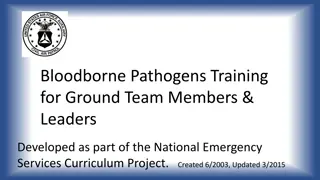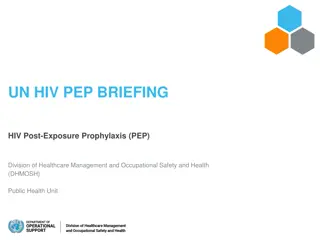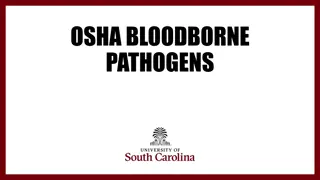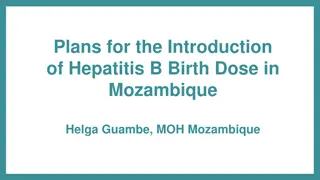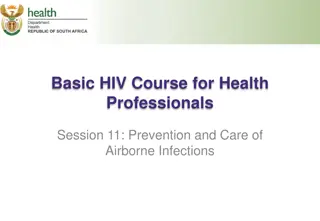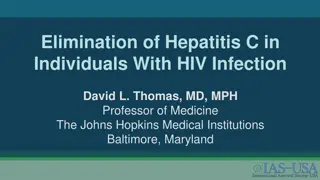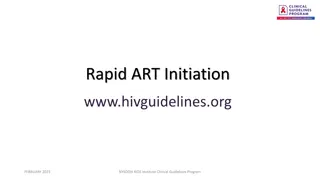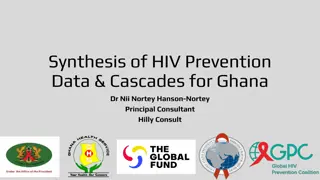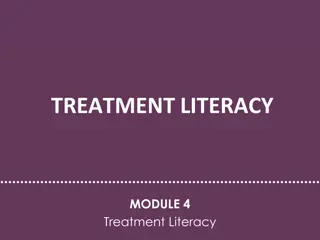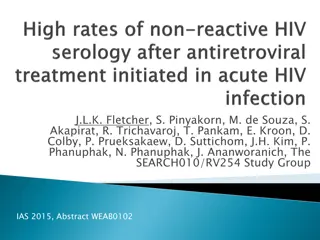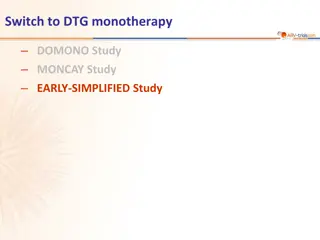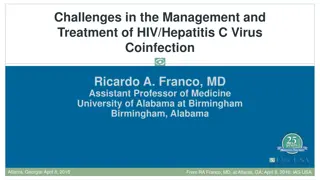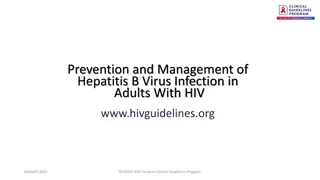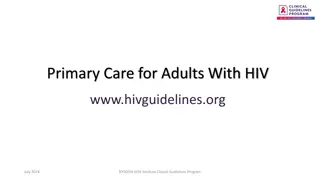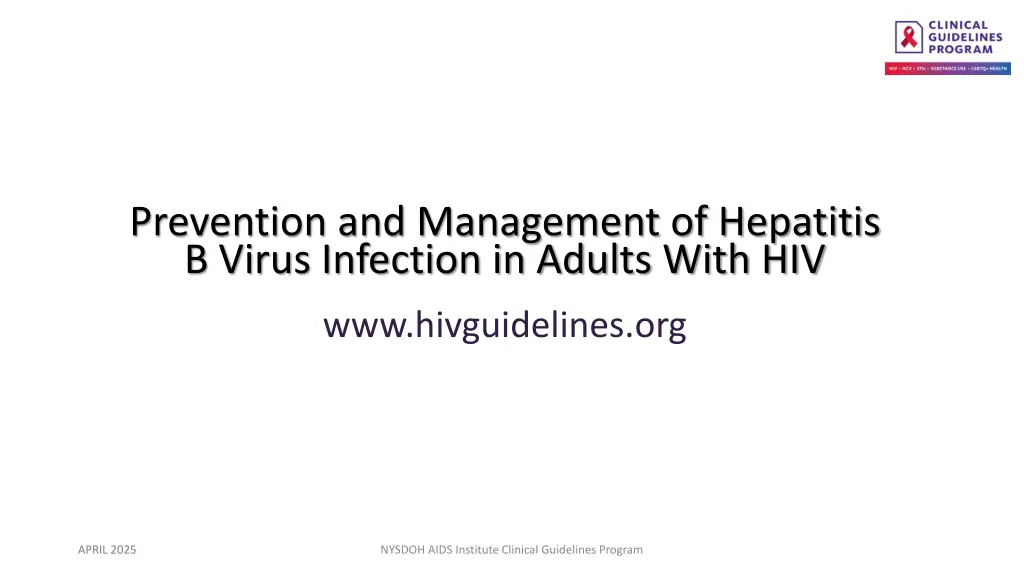
Prevention & Management of Hepatitis B in HIV-Infected Adults
This guideline outlines the prevention and management strategies for Hepatitis B virus infection in adults with HIV, including the importance of screening, vaccination, diagnosis, treatment, and monitoring. It also covers New York State reporting requirements and recommendations for screening tests and interpretation of results.
Download Presentation

Please find below an Image/Link to download the presentation.
The content on the website is provided AS IS for your information and personal use only. It may not be sold, licensed, or shared on other websites without obtaining consent from the author. If you encounter any issues during the download, it is possible that the publisher has removed the file from their server.
You are allowed to download the files provided on this website for personal or commercial use, subject to the condition that they are used lawfully. All files are the property of their respective owners.
The content on the website is provided AS IS for your information and personal use only. It may not be sold, licensed, or shared on other websites without obtaining consent from the author.
E N D
Presentation Transcript
Prevention and Management of Hepatitis B Virus Infection in Adults With HIV www.hivguidelines.org APRIL 2025 NYSDOH AIDS Institute Clinical Guidelines Program
Purpose of This Guideline Purpose of This Guideline The goals of this guideline are to: Raise awareness among clinicians about the prevalence and associated risks of chronic HBV in patients with HIV. Increase screening for and vaccination against HBV in adults with HIV. Provide up-to-date, evidence-based recommendations on diagnosis, assessment, treatment, and monitoring of chronic HBV infection in patients with HIV, with emphasis on the essential components of antiretroviral therapy to treat coinfection. APRIL 2025 NYSDOH AIDS Institute Clinical Guidelines Program www.hivguidelines.org
New York State Law: Reporting HBV Infection New York State Law: Reporting HBV Infection Clinicians must report all suspected or confirmed HBV infections, and specify acute or chronic, to the local health department of the area where the individual resides according to NYSDOH Communicable Diseases Reporting Requirements. APRIL 2025 NYSDOH AIDS Institute Clinical Guidelines Program www.hivguidelines.org
Recommendations: Screening Tests Recommendations: Screening Tests Clinicians should determine the HBV vaccination and immune status of patients with HIV by performing laboratory testing for HBsAg, anti- HBs, and anti-HBc (total). (A*) See Interpretation of HBV Screening Test Results. Clinicians should repeat laboratory screening annually in patients who are not immune to HBV, choose not to be vaccinated, and are at ongoing risk of acquiring HBV. (A3) APRIL 2025 NYSDOH AIDS Institute Clinical Guidelines Program www.hivguidelines.org
Interpretation of HBV Screening Test Results Interpretation of HBV Screening Test Results Anti-HBc HBsAg Anti-HBs IgG IgM Interpretations Negative Negative Negative Negative Susceptible to HBV infection Negative Positive Negative Negative Immune due to HBV vaccination Negative Positive Positive Negative Immune due to natural HBV infection Positive Negative Positive Positive Acute HBV infection Positive Negative Positive Negative/Positive Chronic HBV infection Negative Negative Positive Negative/Positive Isolated anti-HBc positivity. Possible interpretations: Resolved HBV infection with waning anti-HBs titers False-positive result Occult HBV infection Resolving acute HBV infection APRIL 2025 NYSDOH AIDS Institute Clinical Guidelines Program www.hivguidelines.org
Recommendations: Diagnosis Recommendations: Diagnosis In patients with positive baseline (screening) HBsAg test results, clinicians should perform HBeAg, anti-HBe, and HBV DNA testing to diagnose the phase of HBV infection. (B2 ) See Serologic and Virologic Responses to HBV Infection. If a patient with HIV and unknown HBsAg status has signs or symptoms of acute hepatitis (i.e., elevated ALT), the clinician should perform HBsAg, anti-HBc IgM, HBeAg, anti-HBe (A*), and HBV DNA (A3) testing along with other diagnostic testing for acute hepatitis. APRIL 2025 NYSDOH AIDS Institute Clinical Guidelines Program www.hivguidelines.org
Serologic and Virologic Responses to HBV Serologic and Virologic Responses to HBV Infection Infection Anti-HBc IgG Anti-HBc IgM Stage of Infection HBsAg Anti-HBs HBeAg Anti-HBe HBV DNA Level Incubation + + or Low Acute HBV infection + + + + High HBs-negative acute HBV + + + or High Inactive HBsAg carrier + +++ + or + Low Precore mutant + + or + or + High Occult infection + + or High or low Chronic HBV infection + +++ + or + or High or low APRIL 2025 NYSDOH AIDS Institute Clinical Guidelines Program www.hivguidelines.org
Recommendations: Acute HBV Infection Recommendations: Acute HBV Infection If acute HBV infection is confirmed and the patient is asymptomatic, the clinician should repeat ALT testing within 2 to 4 weeks to assess for symptoms of liver disease progression (B3) and repeat HBsAg, HBeAg, anti-HBe, and HBV DNA testing 6 months later to determine whether infection has cleared. (A3) If a patient with HIV and acute HBV is not taking ART, the clinician should recommend ART initiation. (A1) APRIL 2025 NYSDOH AIDS Institute Clinical Guidelines Program www.hivguidelines.org
Recommendations: Transmission Prevention Recommendations: Transmission Prevention Clinicians should advise patients who have a positive HBsAg test result that they can transmit HBV (A*) and encourage sexually active patients to use effective barrier protection to reduce the risk of HBV transmission. (A2 ) Clinicians should inform patients with HBV that their household contacts should be vaccinated and counsel the patients to avoid sharing items such as razors or toothbrushes that could expose others to HBV-contaminated blood. (A2 ) For individuals who inject drugs, clinicians should offer or refer for substance use treatment, ensure access to clean needles and syringes, and provide harm reduction counseling. (A2 ) APRIL 2025 NYSDOH AIDS Institute Clinical Guidelines Program www.hivguidelines.org
Typical Serologic Course of Acute HBV Infection Typical Serologic Course of Acute HBV Infection With Recovery With Recovery Reprinted from Centers for Disease Control and Prevention Recommendations for Identification and Public Health Management of Persons with Chronic Hepatitis B Virus Infection. APRIL 2025 NYSDOH AIDS Institute Clinical Guidelines Program www.hivguidelines.org
Algorithm for HBV Screening and Vaccination in Algorithm for HBV Screening and Vaccination in Patients With HIV Patients With HIV Notes: a. In patients with positive anti-HBc, negative anti-HBs, and negative HBsAg test results, vaccinate with 1 standard dose of Heplisav-B and check anti-HBs titer after 8 weeks. If titer is <100 mlU/mL, complete remaining dose in the vaccine series and recheck titer at least 8 weeks after the last vaccine. b. In patients with anti-HBs levels <10 mlU/mL (vaccine nonresponse), revaccination is recommended. If the Heplisav-B vaccine series was administered as the initial HBV vaccination, revaccinate with a third dose of Heplisav-B. If the Heplisav-B vaccine series was not administered as the initial HBV vaccination, revaccinate with a 2-dose series of Heplisav-B. c. A patient who is negative for all serologies and who does not respond to revaccination may have a primary nonresponse or chronic infection. HBV DNA testing may be used to detect the presence of chronic HBV infection. APRIL 2025 NYSDOH AIDS Institute Clinical Guidelines Program www.hivguidelines.org
Recommendations: Primary Vaccination Recommendations: Primary Vaccination Clinicians should offer an HBV vaccine to patients with negative test results for HBsAg, anti-HBs, and anti-HBc: Preferred: 2-dose Heplisav-B vaccine series (A2) Alternative: 3-dose Engerix-B or Recombivax HB vaccine series (A1) Clinicians should not defer initial HBV vaccination in patients with a CD4 count <200 cells/mm3 who are at risk for HBV infection. (A2) Clinicians should repeat anti-HBs testing 4 to 16 weeks, based on the patient s visit schedule, after completion of the vaccination series to ensure immunity (anti-HBs 10 mIU/mL). (A3) In a patient with negative HBsAg, negative anti-HBs, and positive anti-HBc test results (isolated anti-HBc positive), the clinician should offer a single dose of Heplisav-B. (A2) Repeat anti-HBs testing 8 weeks after vaccination, and if the anti-HBs titer is <100 mIU/mL, complete the HBV vaccine series and repeat anti-HBs testing at least 8 weeks after the last vaccine. (A2) If vaccination is refused or if follow-up anti-HBs titer testing cannot be assured, perform HBV DNA testing to evaluate for occult HBV infection. (A2) Clinicians should not defer initial vaccination or revaccination in pregnant patients with HIV who do not have immunity to HBV. (A3) APRIL 2025 NYSDOH AIDS Institute Clinical Guidelines Program www.hivguidelines.org
HBV Vaccine Dosing Schedule* HBV Vaccine Dosing Schedule* Vaccine Dosing Notes Heplisav-B [a] Single dose: 20 g as one 0.5 mL dose containing 20 g/mL vaccine administered as follows: 2 IM injections at weeks 0 and 4 Patients with ESRD: Standard dosing Engerix-B Single dose: 20 g as one 1 mL dose containing 20 g/mL vaccine administered as follows: 3 IM injections at weeks 0, 4, and 24 OR 4 IM injections at weeks 0, 4, 8, and 24 Double dose: 40 g as two 1 mL doses of 20 g/mL vaccine administered as follows: 3 IM injections at weeks 0, 4, and 24 OR 4 IM injections at weeks 0, 4, 8, and 24 Patients with ESRD or other immunocompromising conditions [b]: 40 g/mL as two 1 mL doses of 20 g/mL vaccine administered in 3 IM injections at weeks 0, 4, 8, and 24 Recombivax HB Single dose: 10 g as one 1 mL dose containing 10 g/mL vaccine administered as follows: 3 IM injections at weeks 0, 4, and 24 OR 4 IM injections at weeks 0, 4, 8, and 24 Double dose [c]: 20 g as two 1 mL doses containing 10 g/mL vaccine administered as follows: 3 IM injections at weeks 0, 4, and 24 OR 4 IM injections at weeks 0, 4, 8, and 24 Patients with ESRD or other immunocompromising conditions [b]: 40 g/mL as 1 mL of higher-strength vaccine administered in 4 IM injections at weeks 0, 4, and 24 Twinrix [d] Single dose: 1 mL administered as follows: 3 IM injections at weeks 0, 4, and 24 For patients who are not immune to either HBV or HAV *See notes on next slide. APRIL 2025 NYSDOH AIDS Institute Clinical Guidelines Program www.hivguidelines.org
HBV Vaccine Dosing Schedule HBV Vaccine Dosing Schedule Notes: a. Double dosing and an accelerated schedule with Heplisav-B have not been well studied. b. Higher-strength regimens of both Engerix-B and Recombivax HB are approved by the FDA for use in patients with ESRD; these higher-strength regimens may also be considered for patients with other immunocompromising conditions. c. Double dosing with Recombivax HB has not been as well studied as double dosing with Engerix-B. However, Recombivax HB may be the only formulation available at some institutions. d. Double dosing and use of a 4-dose series with Twinrix have not been well studied in patients with HIV and are not recommended. APRIL 2025 NYSDOH AIDS Institute Clinical Guidelines Program www.hivguidelines.org
Recommendations: Revaccination Recommendations: Revaccination In previously vaccinated patients with anti-HBs levels <10 mIU/mL (vaccine nonresponse), clinicians should recommend revaccination. (A2) If the Heplisav-B vaccine series was not administered as the initial HBV vaccination, revaccinate with a 2-dose series of Heplisav-B. (A1) If the Heplisav-B vaccine series was administered as the initial HBV vaccination, revaccinate with a third dose of Heplisav-B. (A2) If patients have contraindications to Heplisav-B, revaccinate with a double dose of Engerix-B or Recombivax HB. (A2) APRIL 2025 NYSDOH AIDS Institute Clinical Guidelines Program www.hivguidelines.org
Key Point: Follow Key Point: Follow- -up Testing up Testing Patient education regarding HBV vaccination is important to ensure awareness of the continued risk of acquiring and subsequently transmitting HBV until adequate anti-HBs response is confirmed. APRIL 2025 NYSDOH AIDS Institute Clinical Guidelines Program www.hivguidelines.org
Recommendations: Liver Disease Assessment Recommendations: Liver Disease Assessment Before initiating HBV treatment in patients with HIV, clinicians should obtain a complete physical examination and medical history, including the use of hepatoxic medications (A*); noninvasive fibrosis evaluation (A2 ); baseline ultrasonography for HCC (A2 ); and the following laboratory testing: CBC, albumin, bilirubin, alkaline phosphatase, PT/INR, ALT, AST, and a basic metabolic panel. (A*) Clinicians should refer patients with HIV/HBV coinfection and cirrhosis to a gastroenterologist or hepatologist to assess and manage complications of portal hypertension. (A3) In patients with HIV/HBV coinfection and cirrhosis, clinicians should screen for HCC with ultrasound every 6 months. (A2 ) APRIL 2025 NYSDOH AIDS Institute Clinical Guidelines Program www.hivguidelines.org
Recommendations: Recommendations: Alcohol Use Screening and Education Alcohol Use Screening and Education Clinicians should perform alcohol use screening in patients with HIV/HBV coinfection at baseline and at least annually and refer patients for treatment as needed. (A3) Clinicians should educate patients about the detrimental effects of alcohol use on the course of HBV infection and counsel patients with underlying liver disease to abstain from or minimize alcohol use. (A*) APRIL 2025 NYSDOH AIDS Institute Clinical Guidelines Program www.hivguidelines.org
Recommendations: HAV, HCV, and HDV Status Recommendations: HAV, HCV, and HDV Status Clinicians should perform anti-HAV IgG or total (IgM and IgG) serum testing and administer the full HAV vaccine series in patients who are not immune to HAV. (A3) Clinicians should determine patients HCV status by medical history and serum testing and recommend treatment with DAA therapy if chronic HCV infection is diagnosed. (A1) Clinicians should perform anti-HDV total (IgM and IgG) serum testing to screen for HDV in all patients with HIV/HBV coinfection. (B2) APRIL 2025 NYSDOH AIDS Institute Clinical Guidelines Program www.hivguidelines.org
Recommendations: Treatment Recommendations: Treatment Clinicians should recommend immediate ART initiation for any patient with HIV/HBV coinfection who is not taking ART. (A1) Preferred: In patients with HIV and chronic HBV, clinicians should recommend an ART regimen that includes 2 agents active against HBV (see Available Medications for Treatment of HBV Infection in Adults With HIV). Preferred regimens include a backbone of either TAF/FTC, TDF/FTC, or TDF/3TC. (A2) Clinicians should not prescribe a 2-drug regimen of TAF/FTC, TDF/FTC, or TDF/3TC alone to treat patients with HIV/HBV coinfection; a fully suppressive ART regimen is required. (A1) Nonadherence with or discontinuation of anti-HBV treatment may result in transaminase flares and hepatic damage. Clinicians should educate patients about the treatment adherence requirements (A*), and if treatment must be interrupted or discontinued, consult with a care provider experienced in HIV/HBV coinfection. (A3) Alternative: If a patient cannot or chooses not to take TDF or TAF, the clinician should initiate treatment with ETV and a fully suppressive ART regimen for HIV. (A3) APRIL 2025 NYSDOH AIDS Institute Clinical Guidelines Program www.hivguidelines.org
Available Medications for Treatment of HBV Available Medications for Treatment of HBV Infection in Adults With HIV Infection in Adults With HIV Medication Clinical Comment A prodrug of the NRTI tenofovir active against HIV and HBV, including 3TC-resistant HBV A preferred agent for chronic HBV treatment because of its high virologic efficacy and low risk of HBV resistance Potential association with renal impairment and loss of bone density Initiate only in patients with CrCl 50 mL/min. A prodrug of the NRTI tenofovir active against HIV and HBV that achieves higher intracellular concentrations in peripheral blood mononuclear cells and hepatocytes than TDF Improved biomarkers for renal and bone safety compared with TDF while maintaining high rates of HIV and HBV viral suppression In HIV/HBV coinfection, switching from a TDF- to a TAF-containing regimen demonstrated similarly high levels of HBV virologic control. Initiate only in patients with CrCl 30 mL/min. An HBV reverse transcriptase inhibitor and HIV NRTI active against HIV and HBV Has a low genetic barrier to HIV and HBV resistance and should not be used as the sole anti-HBV drug in an ART regimen. Studies found the rate of HBV resistance reached 90% after 4 years of 3TC monotherapy. Avoid 3TC monotherapy. Tenofovir disoproxil fumarate (TDF) Tenofovir alafenamide (TAF) Lamivudine (3TC) APRIL 2025 NYSDOH AIDS Institute Clinical Guidelines Program www.hivguidelines.org
Available Medications for Treatment of HBV Available Medications for Treatment of HBV Infection in Adults With HIV, Infection in Adults With HIV, continued Medication Clinical Comment An NRTI similar to 3TC and active against HIV and HBV 3TC-resistant isolates are also cross-resistant to FTC. Do not use as the sole anti-HBV drug in an ART regimen. An NRTI active against HIV and HBV May select for 3TC- and FTC-resistant HIV ETV monotherapy for HBV is not recommended in patients with HIV unless combined with a fully active ART regimen to treat HIV. IFN alfa-2a or -2b or PEG-IFN alfa-2a is used as HBV treatment in patients with HBV monoinfection. Contraindicated in patients with decompensated liver disease (Child-Turcotte-Pugh class B or C) PEG-IFN alfa-2a monotherapy for up to 48 weeks may be considered for HBV treatment in patients with HIV/HBV coinfection if concurrent ART active against HIV and HBV is not possible. PEG-IFN alfa-2a is not associated with HBV drug resistance. Emtricitabine (FTC) Entecavir (ETV) Interferon (IFN) APRIL 2025 NYSDOH AIDS Institute Clinical Guidelines Program www.hivguidelines.org
Recommended Additions to 2 Recommended Additions to 2- -Drug HIV ART Regimens for Patients With Chronic HBV Regimens for Patients With Chronic HBV Drug HIV ART 2-Drug HIV ART Regimen Addition for HBV Treatment DTG/3TC TAF, TDF, or ETV DTG/RPV TAF/FTC, TDF/FTC, TDF/3TC, ETV/FTC, or ETV/3TC CAB/RPV TAF/FTC, TDF/FTC, TDF/3TC, ETV/FTC, or ETV/3TC APRIL 2025 NYSDOH AIDS Institute Clinical Guidelines Program www.hivguidelines.org
Recommendation: Pregnant Patients Recommendation: Pregnant Patients Clinicians should offer pregnant patients treatment with an ART regimen that includes 2 agents active against both HIV and HBV; 3TC, FTC, TAF, and TDF can be used safely during pregnancy at standard doses. (A2 ) APRIL 2025 NYSDOH AIDS Institute Clinical Guidelines Program www.hivguidelines.org
Recommendations: Monitoring Recommendations: Monitoring After HBV treatment initiation, clinicians should perform the laboratory testing listed in Recommended Monitoring After HBV Treatment Initiation in Adults With HIV. (A3) If a patient being treated for chronic HBV develops signs or symptoms of acute hepatitis (nausea, vomiting, elevated ALT or bilirubin levels), the clinician should rule out HBV IRIS and HDV flare and consult with an HIV-experienced hepatologist. (A3) APRIL 2025 NYSDOH AIDS Institute Clinical Guidelines Program www.hivguidelines.org
Recommended Monitoring After HBV Recommended Monitoring After HBV Treatment Initiation in Adults With HIV Treatment Initiation in Adults With HIV Laboratory Test Every 3 Months Every 6 Months Every 12 Months HBV DNA Until HBV DNA is undetectable [a] After HBV DNA is undetectable HBeAg Check for HBeAg-negative result [b] Electrolyte panel X Serum creatinine X Urinalysis X Liver function panel Until HBV DNA is undetectable [a] After HBV DNA is undetectable Notes: a. b. Undetectable is defined as <10 IU/mL. Patients who have been taking anti-HBV treatment for several years may not convert to HBeAg-negative. APRIL 2025 NYSDOH AIDS Institute Clinical Guidelines Program www.hivguidelines.org
Need Help? Need Help? NYSDOH AIDS Institute Clinical Guidelines Program www.hivguidelines.org
Access the Guideline Access the Guideline www.hivguidelines.org > Prevention and Management of Hepatitis B Virus Infection in Adults With HIV Also available: Printable pocket guide and PDF Podcast:Viremic Cases in HIV Find all episodes at viremic.org NYSDOH AIDS Institute Clinical Guidelines Program www.hivguidelines.org


